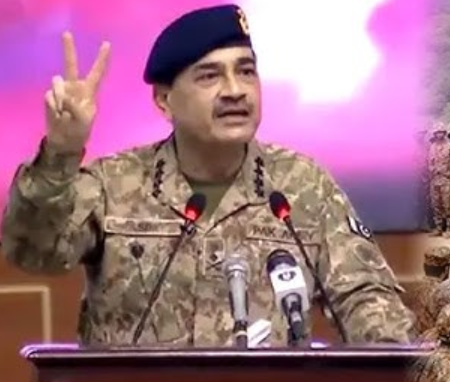A quiet but dangerous shift is unfolding in South Asia’s balance of power — and at the center of it is Pakistan’s military chief, Field Marshal Asim Munir. Backed by renewed ties with Washington and emboldened by regional upheaval, Munir appears to be steering Pakistan toward a more aggressive and unconventional posture against India. And this time, the eastern frontier may be the battleground.
From Kashmir to the Northeast: A Strategic Pivot
In a revealing interview with The Economist, Pakistan’s military spokesperson, Lt. Gen. Ahmed Sharif Chaudhry, delivered a statement that raised eyebrows: “We’ll start from the East.” It wasn’t just posturing. The comment points to a growing Pakistani interest in opening a new front against India—not through the familiar conflict zone of Kashmir, but through India’s northeast, where geopolitical developments are creating fresh vulnerabilities.
This strategic shift is informed by more than military tactics. It reflects a broader recalibration within Islamabad’s military leadership as Munir consolidates power at home and courts foreign support abroad.
Bangladesh’s Political Shift: An Opening for Pakistan
The power transition in Bangladesh in early 2025 has had cascading effects across the region. Under Sheikh Hasina, Dhaka maintained close security cooperation with India and cracked down on extremist elements. Her replacement by a more Islamist-leaning government has reversed that trajectory.
With the new leadership in Dhaka warming up to Pakistan and easing restrictions on radical groups, reports have emerged of renewed links between Pakistani intelligence and Islamist factions operating in Bangladesh. Arms smuggling routes are reportedly active again in the Chittagong Hill Tracts, and cross-border movement in India’s northeast has increased, complicating New Delhi’s security calculus.
Pakistan seems keen to leverage these developments to stretch India’s defenses, particularly in regions where security infrastructure is less robust and insurgent activity has historically simmered.
Munir’s U.S. Outreach: A Tactical Boost
Munir’s geopolitical play isn’t confined to South Asia. His outreach to the United States appears to be paying dividends. His high-profile meeting with President Donald Trump at the White House in June 2025, followed by a Pakistani civilian award for CENTCOM’s General Michael Kurilla, suggests a revival of the U.S.-Pakistan security partnership.
Trump’s administration, meanwhile, has taken a harder line against India, imposing tariffs and making provocative remarks that seem to signal a shift in Washington’s regional tilt—at least rhetorically. For Pakistan’s military establishment, this presents an opportunity to reassert itself as a strategic player, not only in South Asia but also in wider Islamic world politics and even Middle East diplomacy.
This renewed access to U.S. diplomatic capital gives Munir greater room to maneuver — and possibly challenge India in areas previously considered off-limits.
Eastern Front: An Asymmetric Playbook
India’s northeast has long been a sensitive region, marked by porous borders, ethnic fault lines, and periodic unrest. From West Bengal to Assam and Tripura, the cultural and linguistic commonalities across borders allow for a degree of movement and anonymity that isn’t possible along the heavily guarded Line of Control in Kashmir.
Pakistan appears to be exploring the possibility of activating proxy networks in the east — not through direct military engagement, but via hybrid tactics: disinformation campaigns, cyber operations, and support for insurgent elements.
Unlike the overt confrontations of the past, this new model of engagement is murkier and deniable — tailor-made for exploiting areas where India’s surveillance and counterinsurgency capabilities are still evolving.
India’s Response: Heightened Alert and Strategic Refocus
India’s security apparatus isn’t taking the eastern threat lightly. Since early 2025, military intelligence and paramilitary forces in Assam and Meghalaya have been ramping up surveillance. Reports suggest that diplomatic channels are also active, with New Delhi seeking to build regional consensus to isolate Pakistan in the event of renewed hostilities.
India is also recalibrating its posture — shifting some of its strategic attention from the western border to the vulnerable northeastern corridor. This comes in the wake of Operation Sindoor, India’s deep-strike retaliation earlier this year that saw multiple Pakistani terror camps and air bases hit. While that operation showcased India’s growing technological and military capacity, it may have also provoked Pakistan to find new, less predictable routes of escalation.
The Risk of Escalation: A Two-Front Gamble
Munir’s approach marks a significant evolution in South Asian geopolitics. By widening the theatre of potential conflict, he aims to pressure India into overextension—both militarily and diplomatically. But this is a high-risk strategy.
If Pakistan miscalculates, it could trigger a wider confrontation with a much more prepared and assertive Indian military. At the same time, India must now prepare not just for open conflict in Kashmir but for a murky, hybrid war in the east — one that blends insurgency, propaganda, and proxy violence.
Conclusion: The Game Is Changing
What’s unfolding isn’t just another chapter in the India-Pakistan rivalry — it’s the beginning of a more complex, multi-front conflict architecture. Munir’s strategy may give Pakistan temporary leverage, but it also drags the subcontinent closer to unpredictable escalation.
For India, the challenge is now as much about defending territory as it is about anticipating the shape of future threats — and ensuring it doesn’t get outmaneuvered in a war that’s already being waged in the shadows.
